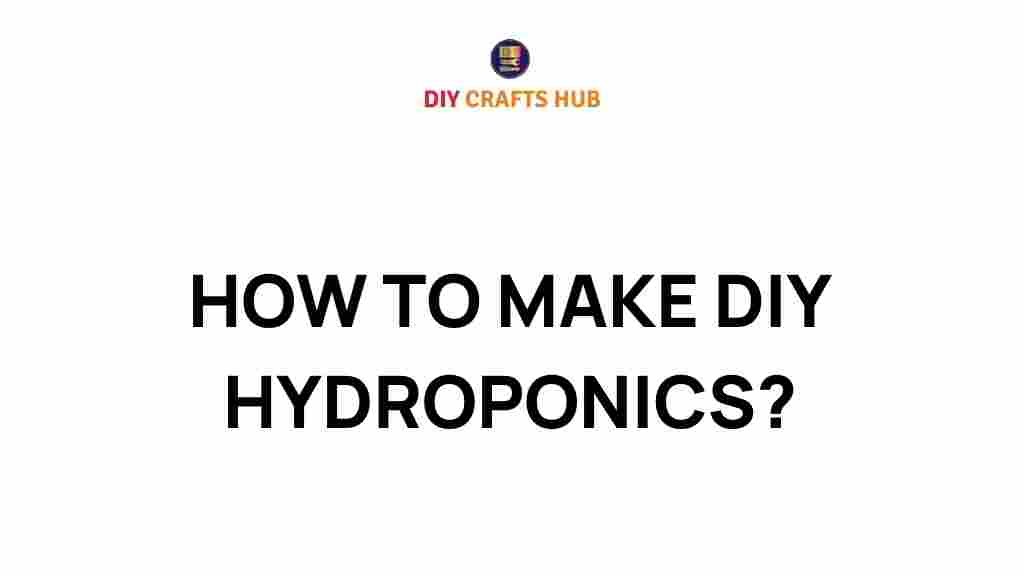Unlocking the Secrets of DIY Hydroponics: A Beginner’s Guide


Unlocking the Secrets of DIY Hydroponics
Welcome to the world of DIY hydroponics, where growing fresh, healthy plants becomes an exciting, sustainable adventure. Whether you want to cultivate your own vegetables, herbs, or flowers, this beginner-friendly guide will help you set up your hydroponic system, troubleshoot common issues, and maximize your yields.
What is DIY Hydroponics?
Hydroponics is a soil-free gardening technique that uses nutrient-rich water to grow plants. DIY hydroponics involves creating your own system, tailored to your space and needs, allowing you to save money and customize the process. This method is perfect for beginners and experts alike, offering year-round gardening possibilities.
Benefits of DIY Hydroponics
Choosing to embark on a hydroponic journey has several advantages:
- Space efficiency: Grow plants in smaller spaces compared to traditional soil gardening.
- Water conservation: Hydroponics uses up to 90% less water than soil gardening.
- Faster growth: Plants grow up to 50% faster due to optimized nutrient delivery.
- No soil dependency: Great for urban gardeners or areas with poor soil quality.
Getting Started with DIY Hydroponics
Before diving in, it’s essential to gather the necessary materials and understand the types of hydroponic systems available. Follow these steps to build your first system.
Step 1: Choose a Hydroponic System
There are several types of hydroponic systems to choose from, including:
- Nutrient Film Technique (NFT): A continuous flow of nutrient solution over plant roots.
- Deep Water Culture (DWC): Plant roots are submerged in oxygenated nutrient water.
- Drip System: Nutrients are delivered to each plant through a drip emitter.
- Ebb and Flow: Nutrient solution floods the plant bed periodically, then drains away.
For beginners, the DWC system is often the easiest and most cost-effective to start with.
Step 2: Gather Materials
To build a basic hydroponic system, you’ll need the following:
- Container or reservoir for water
- Hydroponic nutrients
- Net pots or cups
- Growing medium (e.g., clay pebbles, coco coir)
- Air pump and air stone for oxygenation
- pH testing kit and pH adjusters
- Grow lights (if growing indoors)
Step 3: Assemble Your System
Follow these steps to set up your hydroponic system:
- Prepare the container: Fill your reservoir with water and mix in the hydroponic nutrients according to the package instructions.
- Install the air pump: Attach the air stone to the pump and place it in the reservoir to oxygenate the water.
- Place plants in net pots: Add the growing medium to each pot, ensuring the plant roots are exposed to the water below.
- Monitor pH levels: Test the water’s pH and adjust to a range of 5.5–6.5 for optimal nutrient uptake.
- Set up lighting: Position grow lights above the plants, maintaining a consistent light schedule of 12–16 hours daily.
Step 4: Plant Care and Maintenance
Once your DIY hydroponic system is running, regular care is essential:
- Check water levels daily and top up as needed.
- Monitor nutrient concentration and adjust every 1–2 weeks.
- Inspect plants for signs of pests or nutrient deficiencies.
Troubleshooting Common Issues
Even the best systems encounter challenges. Here are solutions to common problems:
- Yellowing leaves: Check for nutrient imbalances or pH fluctuations.
- Root rot: Ensure proper aeration and avoid over-saturating roots.
- Algae growth: Cover exposed areas of water to block light.
- Slow plant growth: Verify light intensity and nutrient availability.
Tips for Success
Maximize the efficiency of your hydroponic system with these tips:
- Start small and scale up as you gain experience.
- Keep a log of water, nutrient, and pH adjustments for better tracking.
- Experiment with different plants to find what grows best in your system.
For more insights on advanced techniques, visit our detailed hydroponics resource page.
Conclusion
With DIY hydroponics, you can enjoy fresh, sustainable produce right at home. By following this guide, you’ll create a system that not only saves space and resources but also provides a rewarding gardening experience. Whether you’re growing leafy greens, juicy tomatoes, or fragrant herbs, the possibilities are endless.
Ready to dive deeper? Check out this external guide on hydroponic farming for additional expert tips.
This article is in the category Home & Decor and created by DIYCraft Team
Recent Posts
How to Make a DIY Stethoscope: Craft Your Own Medical Tool
Discover how to make a DIY stethoscope for educational fun and creativity. Perfect for healthcare…
Master the Art of Silence: How to Stop a Door from Slamming
Discover DIY solutions to stop a door from slamming and create a quieter home environment…
Unlocking Hidden Potential: How to Maximize Closet Space DIY
Discover how to maximize closet space with innovative DIY organization tips that will transform your…
Transform Your Ride: A DIY Guide to Attaching Your Phone to Your Bike
Discover how to create a DIY phone mount for your bike to ensure hands-free riding…
Master the Art of DIY Poo Pourri: Transform Your Bathroom Experience
Discover how to make DIY Poo Pourri and elevate your bathroom experience with this simple,…
Unlocking Space: How to Extend Cabinets to the Ceiling in Your Home
Discover how to extend cabinets to the ceiling and maximize storage space in your home…